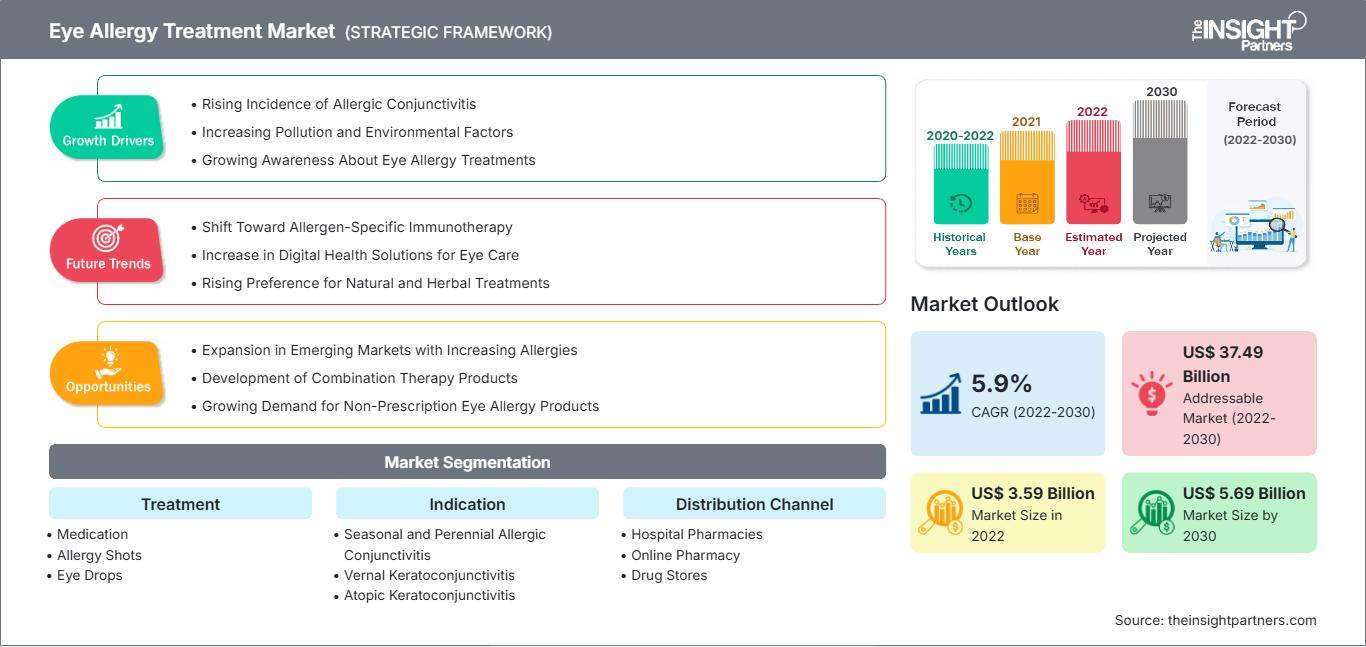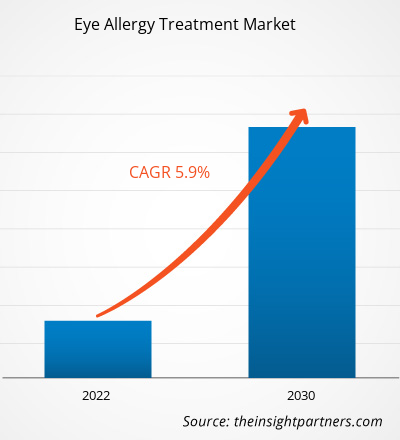[研究报告] 眼部过敏治疗市场规模预计将从2022年的35.9亿美元增至2030年的56.9亿美元;预计2022年至2030年期间的复合年增长率将达到5.9%。
市场洞察与分析师观点:
眼部过敏治疗包括非处方药和处方药,用于缓解眼睛发红、瘙痒、流泪和肿胀等症状。一些常用的产品包括抗组胺眼药水、肥大细胞稳定剂和联合疗法。眼部过敏的主要类型包括季节性或常年性过敏性结膜炎、春季角结膜炎、特应性角结膜炎和接触性过敏性结膜炎。全球范围内眼部过敏症的患病率不断上升,以及非处方解决方案的普及,这些因素有利于眼部过敏治疗市场的增长。
增长动力:
眼部过敏症,也称为过敏性结膜炎,是由花粉、灰尘、动物和霉菌引起的。空气污染加剧导致眼部过敏症的发病率不断上升。此外,生活方式和饮食习惯的改变、接触过敏原的增加、屏幕时间的增加导致眼疲劳以及对眼部不适的敏感性增加,导致全球人口的眼部过敏反应大幅增加。
根据 2020 年发表的一项题为“过敏性结膜炎的现代观察”的研究,过敏性眼病是北美人群的常见问题。它影响着近 40% 的人口,而且这个数字还在增长。一半的美国人口患有眼部过敏症状,需要药物缓解。尽管如此,其中只有一小部分人使用处方药,这使得这些新疗法的开发尤为引人注目。
眼部过敏治疗包括用于治疗和管理眼部过敏的产品和解决方案。治疗方法包括非处方药和处方药,用于缓解眼睛发红、瘙痒、流泪和肿胀等症状。一些常用的产品包括抗组胺眼药水、肥大细胞稳定剂和非甾体类抗炎药。眼部过敏患者数量的增长导致对治疗方案的需求增加。这增加了对治疗选择的需求,从而推动了眼部过敏治疗市场的增长。
眼部过敏治疗市场趋势包括开发联合疗法,这将有利于未来市场的增长。
自定义此报告以满足您的要求
您将免费获得任何报告的定制,包括本报告的部分内容,或国家级分析、Excel 数据包,以及为初创企业和大学提供超值优惠和折扣
眼部过敏治疗市场: 战略洞察

- 获取本报告的主要市场趋势。这个免费样本将包括数据分析,从市场趋势到估计和预测。
您将免费获得任何报告的定制,包括本报告的部分内容,或国家级分析、Excel 数据包,以及为初创企业和大学提供超值优惠和折扣
眼部过敏治疗市场: 战略洞察

- 获取本报告的主要市场趋势。这个免费样本将包括数据分析,从市场趋势到估计和预测。
报告细分和范围:
眼部过敏治疗市场分析考虑了以下细分领域:治疗、适应症、分销渠道和地域。根据治疗,市场分为药物、过敏针剂和眼药水。根据适应症,市场分为季节性和常年性过敏性结膜炎、春季角结膜炎、特应性角结膜炎、接触性过敏性结膜炎和巨乳头状结膜炎。在分销渠道方面,市场分为医院药房、网上药房和药店。
眼部过敏治疗市场报告的范围涵盖北美(美国、加拿大和墨西哥)、欧洲(法国、德国、英国、西班牙、意大利和欧洲其他地区)、亚太地区(中国、日本、印度、韩国、澳大利亚和亚太其他地区)、中东和非洲(沙特阿拉伯、阿联酋、南非和中东和非洲其他地区)以及南美洲和中美洲(巴西、阿根廷和南美洲和中美洲其他地区)。
分段分析:
眼部过敏治疗市场按治疗方法分为药物、过敏注射和眼药水。 2022年,眼药水市场占有相当大的市场份额。预计2022年至2030年期间,该市场将创下最高的复合年增长率。
根据适应症,市场分为季节性和常年性过敏性结膜炎、春季角结膜炎、特应性角结膜炎、接触性过敏性结膜炎和巨乳头状结膜炎。2022年,季节性和常年性过敏性结膜炎市场在眼部过敏治疗市场中占有相当大的份额,预计2022年至2030年期间将创下最高的复合年增长率。
根据分销渠道,市场细分为医院药房、在线药房和药店。 2022 年,医院药房占据了眼部过敏治疗市场的很大份额。此外,预计在线药房市场在 2022 年至 2030 年期间的复合年增长率最高。
区域分析:
根据地域,眼部过敏治疗市场报告主要分为北美、欧洲、亚太地区、南美和中美以及中东和非洲。2022 年,北美占据了相当大的市场份额。2022 年,美国在该地区占据了最大的市场份额。北美市场的增长归因于现代医疗基础设施的可用性、主要市场参与者的强大存在、眼部过敏和干眼症数量的增加以及尖端药物的引入。根据浸信会健康的数据,近 5000 万美国人患有某种形式的季节性过敏。大约30%的成年人和40%的儿童会出现眼睛、眼睑和泪管过敏反应。
干眼症会导致眼部过敏,进而引发干眼症。干眼症在美国是一种常见但未被充分诊断的疾病。根据2020年发布的美国国家健康与保健调查数据,6.8%的美国成年人口被诊断患有干眼症。根据2019年发表的一篇题为《墨西哥干眼症患者眼表损伤的危险因素:一项基于人群的研究》的文章,近58%的人抱怨眼睛干涩。
制药公司正在改善过敏缓解眼药水等专门治疗的可及性,以扩大其在该地区的业务范围。自2022年3月起,艾尔建的LASTACAFT(0.25%阿卡他定滴眼液)已面向美国眼部过敏患者非处方销售。近期,美国食品药品监督管理局(FDA)批准了LASTACAFT的处方药与非处方药的完全转换,LASTACAFT的原始专利处方药配方现已在线上和销售非处方眼药水的零售店销售。因此,上述因素推动了该地区眼部过敏治疗市场的发展。
眼部过敏治疗市场
The Insight Partners 的分析师已详尽阐述了预测期内影响眼部过敏治疗市场的区域趋势和因素。本节还探讨了北美、欧洲、亚太地区、中东和非洲以及南美和中美洲的眼部过敏治疗市场细分和地域分布。
眼部过敏治疗市场报告范围
| 报告属性 | 细节 |
|---|---|
| 市场规模 2022 | US$ 3.59 Billion |
| 市场规模 2030 | US$ 5.69 Billion |
| 全球复合年增长率 (2022 - 2030) | 5.9% |
| 历史数据 | 2020-2022 |
| 预测期 | 2022-2030 |
| 涵盖的领域 |
By 治疗
|
| 覆盖地区和国家 | 北美
|
| 市场领导者和主要公司简介 |
|
眼部过敏治疗市场参与者密度:了解其对业务动态的影响
眼部过敏治疗市场正在快速增长,这得益于终端用户需求的不断增长,而这些需求的驱动因素包括消费者偏好的不断变化、技术进步以及对产品益处的认知度不断提高。随着需求的增长,企业正在扩展产品线,不断创新以满足消费者需求,并抓住新兴趋势,从而进一步推动市场增长。

- 获取 眼部过敏治疗市场 主要参与者概述
行业发展与未来机遇:
以下列出了全球眼部过敏治疗市场参与者采取的一些举措:
- 2020年9月,雷迪博士实验室(Dr Reddy's Laboratories)在美国市场推出了一款非处方眼部过敏滴剂——盐酸奥洛他定滴眼液。该滴眼液用于暂时缓解因花粉、草、动物毛发和皮屑引起的眼痒。
- 2020年2月,爱尔康公司获得美国食品药品监督管理局(FDA)批准,在美国非处方销售Pataday的每日一次和每日两次眼部过敏缓解剂。 Pataday 品牌采用医生处方排名第一的眼部过敏止痒成分,并包含首款无需处方即可购买的每日一次过敏止痒滴剂。
竞争格局和主要公司:
眼部过敏治疗市场预测可以帮助利益相关者规划增长战略。博士伦 (Bausch + Lomb)、爱尔康 (Alcon)、艾伯维 (AbbVie)、强生 (Johnson & Johnson)、Akorn Inc.、Nicox、参天制药 (Santen Pharmaceutical Co. Ltd)、梯瓦 (Teva Pharmaceutical Industries Ltd)、诺华 (Novartis AG) 和太阳制药 (Sun Pharmaceutical Industries Ltd.) 是市场上的佼佼者。这些公司专注于推出新的高科技产品、改进现有产品并拓展地域范围,以满足全球日益增长的消费者需求。
- 历史分析(2 年)、基准年、预测(7 年)及复合年增长率
- PEST和SWOT分析
- 市场规模、价值/数量 - 全球、区域、国家
- 行业和竞争格局
- Excel 数据集
近期报告
相关报告
客户评价
购买理由
- 明智的决策
- 了解市场动态
- 竞争分析
- 客户洞察
- 市场预测
- 风险规避
- 战略规划
- 投资论证
- 识别新兴市场
- 优化营销策略
- 提升运营效率
- 顺应监管趋势




















 获取免费样品 - 眼部过敏治疗市场
获取免费样品 - 眼部过敏治疗市场